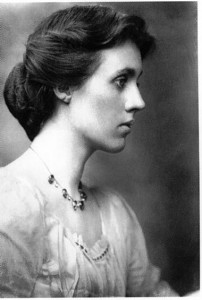 Vanessa and Virginia
Vanessa and Virginia
by Susan Sellers
Houghton Mifflin Harcourt
213 pages, $23.
SUSAN SELLERS’ novel is an imaginative glimpse into the Bloomsbury circle of artists and intellectuals, and the two sisters—painter Vanessa Bell and writer Virginia Woolf—who were at the heart of it. In a series of vignettes, many of them lovely prose poems, Vanessa, the narrator of the novel, addresses Virginia, who is already dead, having killed herself in 1941. Vanessa recalls their complex love–hate relationship, the forces that made them artists, and especially their connections to the men of Bloomsbury, most of whom were homosexual or bisexual.
Sellers barely refers to Virginia Woolf’s own homosexuality. Violet Dickinson, with whom Virginia had a lesbian relationship when she was twenty years old, is introduced briefly and identified only by her first name (as are many other figures in this novel): Vanessa watches Virginia lay her head in Violet’s lap as Violet caresses her hair; and it is then that Vanessa understands the relationship between her sister and the other woman to be more significant than an ordinary friendship. Vita Sackville-West, who was Virginia’s most famous lesbian lover, is presented in a lively two-page vignette that perfectly captures Vita’s flamboyance: she wears orange silk trousers and two black feathers in her hair and cavorts with Virginia wildly and publicly at a Bloomsbury soirée. Virginia tells her sister that Vita will star as an Elizabethan courtier in her next book—which of course is Orlando, though it is never named, and there is no further reference to it or its inspiration. The butch lesbian composer Edith Smyth makes an appearance with Virginia at another soirée, but little is said of her other than the fact that she went to prison as a suffragette, “and now,” Virginia’s husband, Leonard, quips, “she’s an equally belligerent composer.”

Sellers is more interested in the homosexuality of the men of Bloomsbury—“buggers,” Virginia affectionately calls them. The painter Duncan Grant first appears as the lover of Virginia and Vanessa’s brother, Adrian. Other prominent gay figures who have cameo roles or are mentioned in the novel include writer David “Bunny” Garnett, who was another of Duncan’s lovers; Britain’s leading economist John Maynard Keynes, still another of Duncan’s lovers; the writer Lytton Strachey, who was a cousin of Duncan Grant and putatively one of Keynes’ lovers; and the intellectual/mountaineer George Mallory, a Cambridge University chum of all the others who famously died attempting to climb Mt. Everest in 1924. In an era when it was not easy to claim a homosexual identity, all of these men either married or had long-term relationships with women, despite being attracted to other men.
Perhaps the most interesting aspect of the novel is Sellers’ depiction of a heterosexual woman who knows from the start that a man is primarily homosexual and yet cannot help desiring him. Vanessa, who has two sons in an open marriage with Clive Bell, falls madly in love with Duncan Grant immediately after seeing him kiss her brother.
Vanessa and Duncan have a sexual relationship for a time, and he even fathers a child with her, but it is clear that he has much more interest in his male lovers than he does in her. When he goes off to be with other men, Vanessa fears that he’ll fall “blissfully in love” and won’t want her any more. After his affair with David Garnett, she wonders if carnal images of “Bunny” are in his head as he has sex with her. When Duncan writes to her mentioning a new man’s name, she “feels a fresh stab of pain,” because she is afraid that this time the affair will last and Duncan won’t come back. When his affair with the artist Peter Morris is over, Vanessa provides Duncan with “a space to recover” and resolves “to force nothing on him, ask nothing for myself. To have him with me again will be recompense enough.” She allows the daughter she has with Duncan to believe that Clive Bell is her father because “I’m frightened Duncan wouldn’t come at all if he felt there were ties on him as a father.”
At a later point, Virginia intuitively characterizes the relationship between Vanessa and Duncan as being “like brother and sister, fond yet inviolably chaste.” That description sends Vanessa into a tumult of despair: “Your words leave me … shriveled and exposed,” she writes. After Duncan tells Vanessa he will no longer make love to her, she tries to drown herself in a cold river, a foreshadowing of her sister’s suicide.
What can explain this unrequited passion that continued for more than fifty years? Sellers shows that Vanessa thought of Duncan Grant, a fellow artist, as a kindred spirit with whom she could happily paint side-by-side. More darkly, Sellers hints that Vanessa found in Duncan a man who was rejecting her just as did her father, Leslie Stephen, the revered editor of the Dictionary of National Biography. This Freudian insight may go a long way toward explaining Vanessa Bell’s masochistic obsession with someone who cannot give her what she thinks she wants. But it is more puzzling—and perhaps more intriguing—that Duncan Grant was complicit in this neurotic union that lasted virtually until Vanessa’s death in 1961. Surely Vanessa presented more to him than a beard for fifty-plus years. What did he get out of the relationship? Sellers’ decision to tell the story exclusively from Vanessa’s perspective obviates a credible explanation.
Lillian Faderman is the author of the pioneering lesbian history Surpassing the Love of Men, which will be reissued this fall by Alyson Books.





